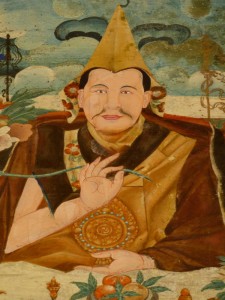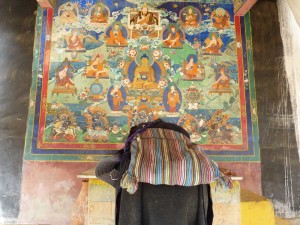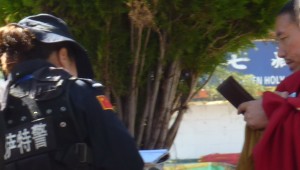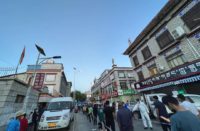High Peaks Pure Earth presents the English translation of a blogpost by Woeser written on October 13, 2011 for the Tibetan service of Radio Free Asia and posted on her blog on October 22, 2011.
This post continues a series making up Woeser’s summer travels to Lhasa, through Amdo and Kham. Previous posts are “Impoverished Mat County”, “Over One Year After the Earthquake, A Rushed Visit to Yushu”, “Sershl Monastery In Recent Years” and “Magnificent Dzogchen Monastery”.
This post has also been translated into French and is available here: http://woeser.wordpress.com/2011/10/29/lhassa-lhassa/



A picture of His Holiness the Dalai Lama in Sera Monastery onto which a work group painted a mustache to try and stop pilgrims and tourists from recognising the Dalai Lama. However, this old Lhasa woman knows it’s the Dalai Lama in the painting, and despite police supervision close by, she still bows deeply … (Photos taken by Woeser on March 30, 2010)
During the era of China’s reform and opening up, Lhasa was generally where the Tibetan elites wanted to be. I met many young Tibetans who could have stayed in big cities like Beijing and Shanghai after graduation but they preferred to go and live and work in Lhasa, which at the time was very far from any hustle and bustle. In the Spring of 1990, I returned from Kham to my birthplace Lhasa, where I had colleagues from Amdo at the Tibet Autonomous Region Literature Association.
Lhasa at the time drew Tibetans from all over like a magnet. Businessmen from Kham and Amdo flooded into Lhasa to do business and monks came to Lhasa’s holy sites and, in accordance with tradition, to study at the Three Great Monasteries. Lhasa, as before, continues to be regarded by Tibetans as a centre where people want to buy a house and to where people want to transfer their hukou (household registration). But even though there were many problems in Lhasa in those days, and even though protests over three consecutive years were suppressed, compared to now there was more space and more possibilities, and it was relatively free and relaxed.
It is not the same now. A Khampa mother and father came to see their daughter who had married a Lhasan and were extremely sad about their daughter when they left because she would be living in a city under the muzzle of a gun. The streets are lined with soldiers and Buddhist monks are being desecrated; Lhasa has changed from being a holy city to a fallen place of dirt and danger.

Monks from outside Lhasa must have documents and permits to go to Lhasa otherwise there is no way they can get past all the checkpoints along the roads. Rinpoches from elsewhere avoid Lhasa and transfer instead to Han areas. Monks from Lhasa itself are cautious and wary and wear plain clothes as much as possible when they are out, and in the old city with the Jokhang Temple at its centre, one often sees police arbitrarily stopping monks in robes or youths in Tibetan dress, checking and registering them. Rinpoches in Lhasa go out as little as possible, as though they live behind closed doors. And there is even mutual wariness between Tibetans, family members don’t even dare speak openly with each other, fearing the possibility that someone might be a snitch or would sell them out. The number of foreigners is unprecedentedly low, tourists are restricted in what they can see and the majority of foreign foundations and NGOs have been driven out.
Tibetan entrepreneurs have either seen their business shrink or they have had to transfer to Tibetan areas in other provinces or to cities in China in order to develop. Even though they don’t adapt too well to the climate, language or lifestyle in Han areas, at least there’s a little less fear in those places. Ever since 2008, many successful Tibetans have been sentenced to imprisonment and there is a general sense of fear among businessmen and entrepreneurs in Tibetan areas. No one knows what tomorrow will bring and no one can say that the wealth people have accrued over the decades will not disappear overnight under trumped-up charges. One businessman used the Buddhist concept of impermanence to describe the situation: like ants, people bit by bit transport and accumulate but the wealth they build with such difficulty can be destroyed in an instant by a bear’s paw; and never mind one’s personal wealth − the wealth that we as a people have accumulated over hundreds and thousands of years, all of it amounted to nothing when the Chinese Communist Party came!
The centripetal forces drawing Tibetans to Lhasa seems to be weakening because the hardships there in all aspects of life are so much worse than elsewhere. Getting a passport, for example, has simply become a fantasy for the majority of Tibetans. Even getting a border travel permit to go on pilgrimage to Mount Kailash is hard. And even though many new communities and new homes have been built in Lhasa, many of them are vacant. Previously, people from Kham and Amdo would have bought a house in Lhasa but now, Tibetans from Lhasa and elsewhere in U-Tsang are buying houses in Chengdu. It’s said that 20,000 Tibetans have bought homes in Chengdu, and of those people a number were probably home owners first in Lhasa but who now refuse to live in the shadow of fear.
Of course, Tibetans are oppressed in other provinces, but less so than in Lhasa. This can be seen from one small detail: from late July to early August I travelled from the Tibetan areas of Qinghai to the Tibetan areas of Sichuan province, and in monasteries and private homes all along the way, portraits of His Holiness the Dalai Lama were openly displayed. Having strictly forbidden them previously, local governments are now turning a blind eye because they not only don’t have the ability to stop it happening, they also fear they would provoke greater protests if they did. But such compromises are nowhere to be seen in Lhasa. On portraits of His Holiness the Dalai Lama in some monasteries, work teams have painted on a mustache to try and stop pilgrims and tourists from recognising the Dalai Lama.
October 13, 2011, Lhasa





Tibet can be free, as the non-communist China as well. Please read more: http://tibetparaomundo.blogspot.com
Best wishes,
FMV.
http://facebook.com/fmarcondesvelloso
http://woeser.middle-way.net/2011/10/blog-post_22.html
Where can we contact High Peaks Pure Earth?